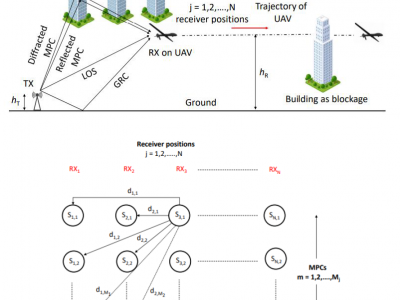Signal Processing

The data is planned to be used in thunderstorm movement path prediction.
- Categories:
 107 Views
107 Views
We present the simulated and real data used in the experiments of the MCA-SAR method. The simulated data is the simulation echo of the existing SAR images, and the real data was collected by RADARSAT-1 in Vancouver on June 16, 2002, which is the public data taken from the book [1].
[1] Cumming I G, Wong F H. Digital Signal Processing of Synthetic Aperture Radar Data: Algorithms and Implementation [M]. London, UK: Artech House, 2005.
- Categories:
 124 Views
124 ViewsGround-to-air (GA) communication using unmanned aerial vehicles (UAVs) has gained popularity in recent years and is expected to be part of 5G networks and beyond. However, the GA links are susceptible to frequent blockages at millimeter wave (mmWave) frequencies. During a link blockage, the channel information cannot be obtained reliably. In this work, we provide a novel method of channel prediction during the GA link blockage at 28 GHz.
- Categories:
 472 Views
472 Views
The dataset contains results of the paper being submitted.
- Categories:
 117 Views
117 Views
The EegDot data set collected using a Cerebus neural signal acquisition equipment involed thirteen odor stimulating materials, five of which (smelling like rose (A), caramel (B), rotten (C), canned peach (D), and excrement (E)) were selected from the T&T olfactometer (from the Daiichi Yakuhin Sangyo Co., Ltd., Japan) and the remaining eight from essential oils (i.e., mint (F), tea tree (G), coffee (H), rosemary (I), jasmine (J), lemon (K), vanilla (L) and lavender (M)).
- Categories:
 349 Views
349 Views
The EegDoc data set collected using a Cerebus neural signal acquisition equipment involved 2 types of odors (smelling like roses and rotten odors), each with 5 concentrations. Five concentrations of the rose odor are expressed as A10-3.0 (A30), A10-3.5 (A35), A10-4.0 (A40), A10-4.5 (A45) and A10-5.0 (A50), and five concentrations of the rotten odor are expressed as C10-4.0 (C40), C10-4.5 (C45), C10-5.0 (C50), C10-5.5 (C55) and C10-6.0 (C60).
- Categories:
 534 Views
534 ViewsIn this paper, we propose a novel cooperative resource sharing in a multi-tier edge slicing networks which is
robust to imperfect channel state information (CSI) caused by user equipments’ (UEs) mobility. Due to the mobility
of UEs, the dynamic requirements of their tasks, and the limited resources of the network, we propose a smart joint
dynamic pricing and resources sharing (SJDPRS) scenario that can incentivize the infrastructure provider (InP) and
mobile network operators (MNOs). Aiming to maximize the profits of UEs, MNOs and the InP under the task
- Categories:
 374 Views
374 Views
We develop a Systematic Mapping Study to observe the fundamentals and techniques used in Data Curation for Big Data. We focus on computational/mathematical techniques, and application scenarios with the aim of answering the following questions: (i) How Mathematics has contributed in the context of Data Curation? (ii) Are there classes of optimization algorithms being used in the context of Data Curation? If yes, which? (iii) In which application scenarios the Data Curation process has presented greater contributions? Our search was performed in some well-known bibliographic sites.
- Categories:
 131 Views
131 ViewsOur data set has 5136 records collected in 214 days. The sampling rate of the sensors is 1 hour. Each record includes the number of vehicles entering and leaving the parking lot in an hour, the CO2 concentration of every building floor at the recording time, and the power consumption of each floor in an hour.
- Categories:
 485 Views
485 Views
This dataset contains simulation output data files of return loss, VSWR, and impedance(imag and real) for non-stacked(0), single-stack(I), double-stack(II), and triple-stack(III) models for supporting the reproducibility. The dataset is in the compressed zip form and contains a folder for each model.
- Categories:
 23 Views
23 Views
